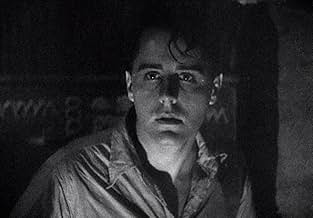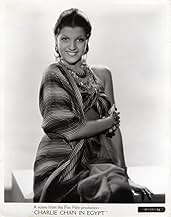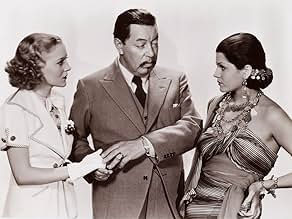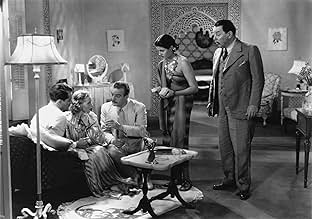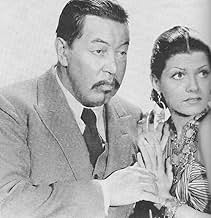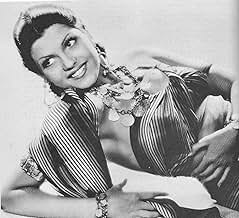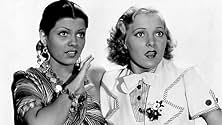IMDb-BEWERTUNG
6,6/10
2255
IHRE BEWERTUNG
Füge eine Handlung in deiner Sprache hinzuWhile investigating the theft of antiquities from an ancient tomb excavation, Charlie discovers the body of the expedition's leader concealed inside the mummy's wrappings.While investigating the theft of antiquities from an ancient tomb excavation, Charlie discovers the body of the expedition's leader concealed inside the mummy's wrappings.While investigating the theft of antiquities from an ancient tomb excavation, Charlie discovers the body of the expedition's leader concealed inside the mummy's wrappings.
- Regie
- Drehbuch
- Hauptbesetzung
Rita Hayworth
- Nayda
- (as Rita Cansino)
John George
- Harip - Grave Opener
- (Nicht genannt)
Gloria Roy
- Bit Girl
- (Nicht genannt)
Empfohlene Bewertungen
I did not like this one on the first viewing, but I had a very bad tape which didn't help. With the DVD (part of recent Chan Collection that came out in 2006) I enjoyed this more, thanks, in part to have the option of English subtitles.
I still think this is a slightly sub-par Warner Oland-edition Charlie Chan, but only because I think so highly of the other films. It did have some excellent suspense and strange characters and is known because of the appearance of young Rita Cansino who would go on to star status as Rita Hayworth.
THE BAD - None of Charlie's kids are here to help him out, and that's a loss. Instead, for humor, we have Stepin Fetchit with his mumbling drawl and unfunny character (unlike Mantan Moreland in later Chans, even though both are horrible black stereotypes of the day.) Worse than the above, we have a shrill, hysterical female lead character , "Carol Arnold" (Pat Paterson) who got on my nerves, big-time! That's almost another stereotype of the period: women who fall apart easily and act like overemotional cripples. After a few of these outbursts, I just hit the mute button when she went into her act. She had a brother in here who was almost as bad except he had far fewer lines. Also in here was the typical thing you saw more of in the '30s than in modern films: stories that dealt with the occult and a lot of superstitions.
THE GOOD - The action was pretty good and this story gave us more of the weird suspects than what is normally provided. Not only weird people but strange scenes. Combine those with the usual Chan witticism's, profound statements and uncommon courtesy he gives everyone, and it's an entertaining film. I would never have recognized Hayworth if I hadn't been informed it was her. She played a dark-haired Egyptian woman. If you froze some frames and looked carefully enough, you could be convinced it was her, but it wasn't easy. She certainly wasn't the incredible beauty she would be in the next decade.
I still think this is a slightly sub-par Warner Oland-edition Charlie Chan, but only because I think so highly of the other films. It did have some excellent suspense and strange characters and is known because of the appearance of young Rita Cansino who would go on to star status as Rita Hayworth.
THE BAD - None of Charlie's kids are here to help him out, and that's a loss. Instead, for humor, we have Stepin Fetchit with his mumbling drawl and unfunny character (unlike Mantan Moreland in later Chans, even though both are horrible black stereotypes of the day.) Worse than the above, we have a shrill, hysterical female lead character , "Carol Arnold" (Pat Paterson) who got on my nerves, big-time! That's almost another stereotype of the period: women who fall apart easily and act like overemotional cripples. After a few of these outbursts, I just hit the mute button when she went into her act. She had a brother in here who was almost as bad except he had far fewer lines. Also in here was the typical thing you saw more of in the '30s than in modern films: stories that dealt with the occult and a lot of superstitions.
THE GOOD - The action was pretty good and this story gave us more of the weird suspects than what is normally provided. Not only weird people but strange scenes. Combine those with the usual Chan witticism's, profound statements and uncommon courtesy he gives everyone, and it's an entertaining film. I would never have recognized Hayworth if I hadn't been informed it was her. She played a dark-haired Egyptian woman. If you froze some frames and looked carefully enough, you could be convinced it was her, but it wasn't easy. She certainly wasn't the incredible beauty she would be in the next decade.
Warner Oland does it again with a great performance as Chan. This one also has a great setting and creepy atmosphere. It is set at a newly excavated Egyptian tomb with all the trappings. There are some genuinely scary sequences creeping around the tomb at night. A young Rita Hayworth (billed as Rita Cansino) has a small part. The only drawback for me is the stereotyped portrayal by Stephin Fechit. He is hard to understand and very annoying at times. The performances by Mantan Moreland and Willie Best in the much later Monogram Chans serve the same niche as Fechit's "Snowshoes" character, but come off much better and are funny in the same way Lou Costello or Curly Howard are funny. But this does not harm the picture. Another one to see over and over again just for the atmosphere if nothing else.
Of the dozens of Charlie Chan films, this stands as one of the best--even though it sadly co-stars the biggest walking negative stereotype in movie history, Stepin Fetchit. Once again, Fetchit plays a rather sub-human part but at least he's a little less degrading than usual and the rest of the film is exceptional.
This film is very much like a combination of a Chan film and a mummy film--and because of the interesting backdrop the film seems far fresher and more interesting than most in the series. Charlie has been sent to an archaeological dig by a French museum. It seems the museum is justifiably angry because items from the tomb belong to them but someone has been selling them to collectors and other museums. Naturally, when Chan arrives people begin to die and it's up to Charlie to get to the bottom of it.
Despite not having any of the Chan children (particularly the ever enjoyable Keye Luke as "Lee"), this is a dandy film with some interesting twists and a mystery that is a tad over-complicated but fun to unravel. As far as my feelings about Fetchit, in this film he didn't act that much different than the Birmingham Brown character from the later Chan film, so perhaps I am just being a tad oversensitive. It's just that in so many prior films Fetchit was the living embodiment of all the negative Black stereotypes--so bad that seeing him once again kind of made me cringe.
This film is very much like a combination of a Chan film and a mummy film--and because of the interesting backdrop the film seems far fresher and more interesting than most in the series. Charlie has been sent to an archaeological dig by a French museum. It seems the museum is justifiably angry because items from the tomb belong to them but someone has been selling them to collectors and other museums. Naturally, when Chan arrives people begin to die and it's up to Charlie to get to the bottom of it.
Despite not having any of the Chan children (particularly the ever enjoyable Keye Luke as "Lee"), this is a dandy film with some interesting twists and a mystery that is a tad over-complicated but fun to unravel. As far as my feelings about Fetchit, in this film he didn't act that much different than the Birmingham Brown character from the later Chan film, so perhaps I am just being a tad oversensitive. It's just that in so many prior films Fetchit was the living embodiment of all the negative Black stereotypes--so bad that seeing him once again kind of made me cringe.
This has always been one of my favourite Warner Oland Chan's, made even more suitably murky and mysterious by the passage of time and the way it's been handled since it was made.
Charlie's in Egypt to track down the person responsible for leaking valuable ancient artifacts into European collections, finding murder as well. With some fantastic atmospheric sets as backdrop and a great cast he and the ever dependable Thomas Beck act as a team to get to the bottom of the mystery and nab the culprit. Every other post has highlighted the main problem with it: Stepin Fetchit. It's a shame they put him in but it's not a problem to me as I don't watch it for him shuffling and mumbling along but for the main story unfolding around the rest of the cast. His major scenes could easily be cut out or altered to save everyone's black and white blushes today - but where would you stop? Airbrush cigarettes, smoke and alcohol, cgi over carbon non-neutral cars or low efficiency lightbulbs, even change Oland to a white Swede and superimpose a black superhero in goodie Beck's place to engage a more proactive and socially inclusive demographic, erase mention of Egypt to try to disguise the colonial connotations etc? And of course if we went that far also add plenty of mindless graphic sex and violence because that's OK in todays crazy world; the Nazis would have simply burned all the prints of this and everything considered similar and revised the history books.
With all its faults I'm grateful for what we've got some of the early Chan's are lost forever at the very least for an insight into the human mental condition as it existed in Hollywood in 1935 but more for as it exists around the world today. If you really don't like it you could campaign for its destruction, but if you like watching pre WW2 b&w middle brow detective movies containing innumerable dead people like this like me watch it without angst as a good film.
Charlie's in Egypt to track down the person responsible for leaking valuable ancient artifacts into European collections, finding murder as well. With some fantastic atmospheric sets as backdrop and a great cast he and the ever dependable Thomas Beck act as a team to get to the bottom of the mystery and nab the culprit. Every other post has highlighted the main problem with it: Stepin Fetchit. It's a shame they put him in but it's not a problem to me as I don't watch it for him shuffling and mumbling along but for the main story unfolding around the rest of the cast. His major scenes could easily be cut out or altered to save everyone's black and white blushes today - but where would you stop? Airbrush cigarettes, smoke and alcohol, cgi over carbon non-neutral cars or low efficiency lightbulbs, even change Oland to a white Swede and superimpose a black superhero in goodie Beck's place to engage a more proactive and socially inclusive demographic, erase mention of Egypt to try to disguise the colonial connotations etc? And of course if we went that far also add plenty of mindless graphic sex and violence because that's OK in todays crazy world; the Nazis would have simply burned all the prints of this and everything considered similar and revised the history books.
With all its faults I'm grateful for what we've got some of the early Chan's are lost forever at the very least for an insight into the human mental condition as it existed in Hollywood in 1935 but more for as it exists around the world today. If you really don't like it you could campaign for its destruction, but if you like watching pre WW2 b&w middle brow detective movies containing innumerable dead people like this like me watch it without angst as a good film.
Charlie Chan comes to Egypt to investigate why certain items found in an archaelogical dig have turned up at rival museums rather than the French museum to which they were promised. It turns out that, while first denying any knowledge, one member of the team does admit selling some smaller items in the collection because funds were needed to continue the operation because the chief archaeologist, Dr. Arnold, out in the field and on a dig, had been unresponsive to any communication and because his spending had been out of control.
But then in a completely unrelated matter Charlie notices that a sarcophagus of one of the Egyptian kings looks like it has been recently tampered with. It is decided that x-rays will be used to look in the sarcophagus, and the image shows a bullet wound in a body that supposedly died three thousand years ago. The coffin is opened and the body of Dr. Arnold is found inside. And so the investigation begins.
I found this Charlie Chan entry from the series rather claustrophobic and slow moving in the middle, although it did have a fascinating dynamite ending. There are only a few suspects from which to choose, and on top of that Dr. Arnold's two grown children are such whiners. Plus the absence of Keye Luke as "number one son" is noticeable and the presence of Stepin Fetchit was grating. On the other hand, Paul Porcasi as an Egyptian version of Inspector Clouseau was a standout.
The end is fascinating though, because Charlie shows his knowledge of forensics and that he does know his way around a crime lab. Mildly recommended, mainly for Oland as Chan.
But then in a completely unrelated matter Charlie notices that a sarcophagus of one of the Egyptian kings looks like it has been recently tampered with. It is decided that x-rays will be used to look in the sarcophagus, and the image shows a bullet wound in a body that supposedly died three thousand years ago. The coffin is opened and the body of Dr. Arnold is found inside. And so the investigation begins.
I found this Charlie Chan entry from the series rather claustrophobic and slow moving in the middle, although it did have a fascinating dynamite ending. There are only a few suspects from which to choose, and on top of that Dr. Arnold's two grown children are such whiners. Plus the absence of Keye Luke as "number one son" is noticeable and the presence of Stepin Fetchit was grating. On the other hand, Paul Porcasi as an Egyptian version of Inspector Clouseau was a standout.
The end is fascinating though, because Charlie shows his knowledge of forensics and that he does know his way around a crime lab. Mildly recommended, mainly for Oland as Chan.
Wusstest du schon
- WissenswertesA young Rita Hayworth appears in a minor role, before she became a star.
- PatzerThe plot revolves around items from the tomb of a high priest of Sekhmet, and the statue of Sekhmet, which are found in the tomb itself. Although Sekhmet was indeed the goddess of revenge, she was not a mortuary goddess. The writers may have confused Sekhmet with Selket, who *was* a mortuary goddess.
- Zitate
Charlie Chan: Drop of water on thirsty tongue more precious than gold in purse.
- VerbindungenEdited into Who Dunit Theater: Charlie Chan in Egypt (2021)
Top-Auswahl
Melde dich zum Bewerten an und greife auf die Watchlist für personalisierte Empfehlungen zu.
- How long is Charlie Chan in Egypt?Powered by Alexa
Details
- Laufzeit
- 1 Std. 13 Min.(73 min)
- Farbe
- Seitenverhältnis
- 1.37 : 1
Zu dieser Seite beitragen
Bearbeitung vorschlagen oder fehlenden Inhalt hinzufügen

